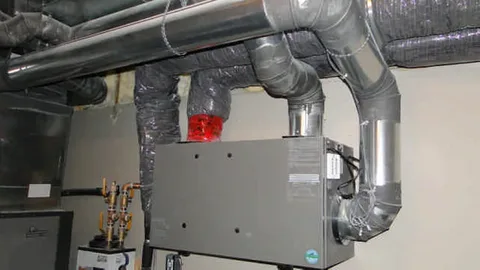Imagine walking into your home and feeling an immediate sense of freshness in the air, like a gentle breeze wafting through an open window on a crisp day. This isn’t just a dream; it can be your reality with Whole House Ventilation. As we spend more time indoors, the quality of our indoor environment has never been more crucial. A well-ventilated home provides comfort and supports our health by ensuring that stale air is replaced with fresh, clean oxygen.
Whole-house ventilation are designed to maintain this balance without wasting energy or breaking the bank. So why should you care about ventilation and heat recovery? The answer lies in creating a healthier living space for you and your loved ones—one where allergens, humidity, and pollutants don’t stand a chance against fresh outdoor air. Let’s explore how these innovative systems work and uncover their many benefits for modern living!
The Importance of Whole-House Ventilation
Whole-house ventilation is essential for maintaining a healthy indoor environment. Many people don’t realize that indoor air can be more polluted than outdoor air, leading to various health issues. Stale air traps allergens, dust, and harmful gases that linger in our homes. Without proper ventilation, these pollutants accumulate and can trigger respiratory problems or allergies.
Moreover, humidity levels play a crucial role in comfort and health. Excess moisture can lead to mould growth and structural damage over time. A well-designed ventilation system helps regulate humidity by allowing excess moisture to escape.
Additionally, whole-house ventilation promotes energy efficiency. By utilizing fresh outdoor air while minimizing heat loss, homeowners can enjoy a comfortable atmosphere without skyrocketing energy bills. Investing in this system transforms your home into a sanctuary of clean air—a vital aspect of modern living that shouldn’t be overlooked.
How Air Ventilation Works?
Air ventilation is essential for maintaining a fresh and healthy indoor environment. It involves air movement in and out of your home, ensuring that stale air is expelled while clean, outdoor air circulates inside.
The process typically starts with an intake system that draws in fresh air from the outside. This new air then travels through ducts or vents into living spaces. Meanwhile, exhaust systems work to remove old, polluted air from areas like kitchens and bathrooms.
Mechanical ventilation can enhance this natural flow by using fans or blowers to control airflow effectively. This method helps regulate temperature and humidity levels, reducing contaminants such as dust, allergens, and odours.
In many modern homes, incorporating energy recovery ventilators optimizes this exchange by transferring heat between incoming and outgoing streams without mixing them. This way, comfort is maintained even during extreme weather conditions.
What is a Heat Recovery System?
A Heat Recovery System is an innovative solution to enhance home energy efficiency. It captures waste heat from exhaust air to precondition incoming fresh air. This process minimizes the energy needed for heating or cooling spaces, making your home more comfortable year-round. By recycling thermal energy, these systems reduce reliance on traditional heating sources.
Typically integrated with a ventilation system, a heat recovery unit works quietly behind the scenes. It ensures you breathe clean, fresh air while maintaining optimal indoor temperatures. With technological advancements, modern systems can be finely tuned to meet specific household needs. They contribute to sustainability and help lower utility bills over time.
Benefits of House Ventilation System
A house ventilation system is pivotal in maintaining a healthy indoor environment. It helps to regulate humidity levels, preventing mould and mildew growth that can compromise your home’s structure and air quality.
Fresh air circulation is essential for eliminating stale odours and reducing indoor pollutants. Continuously bringing in outdoor air creates a more pleasant living space while minimizing the risk of respiratory issues.
Energy efficiency is another significant advantage. With systems designed to recover heat, you can enjoy comfortable temperatures without excessive energy costs. This means enhanced comfort during both cold winters and hot summers.
Moreover, proper ventilation contributes to better overall well-being. A well-ventilated home supports clearer thinking, improved mood, and increased productivity—making it an investment in your health as much as your property’s value.
Types of Mechanical Ventilation and Heat Recovery
Mechanical Ventilation and Heat Recovery comes in different types, each designed to improve air quality effectively. One standard system is the Exhaust Ventilation System. This method removes stale indoor air while creating a vacuum that draws fresh outdoor air into the home.
Another option is the Supply Ventilation System. It pushes conditioned air into your spaces, ensuring a continuous flow of clean and fresh air throughout your living areas. Balanced Ventilation Systems offer an even approach by introducing and exhausting equal amounts of indoor and outdoor air. This helps maintain stable pressure levels inside.
Heat Recovery Ventilators (HRVs) are particularly popular for their energy efficiency. They transfer heat from outgoing stale air to incoming fresh air, reducing heating costs during winter months. Each type has unique advantages and can be tailored to fit specific needs, making it easier to ensure your home stays comfortable and healthy year-round.
Additional Benefits of Whole House Heat Recovery System
Whole house heat recovery system bring more than energy efficiency to your home. One significant advantage is the reduction of allergens and pollutants in indoor air. By continuously replacing stale air with fresh outdoor air, these systems help maintain a healthier living environment.
They also contribute to enhanced comfort levels throughout your home. With balanced airflow, hot or cold spots are minimized, ensuring that every room remains at a consistent temperature. Another benefit lies in noise reduction. These systems operate quietly compared to traditional heating and cooling methods, allowing for a serene atmosphere without disruptive sounds.
Additionally, whole house heat recovery can extend the life of HVAC equipment by reducing strain on heating and cooling units. This leads to fewer repairs and lower maintenance costs over time. Investing in such a system can also increase property value. Energy-efficient homes are increasingly attractive to potential buyers looking for long-term savings.
Improving Indoor Air Quality with Whole House Heat Recovery Ventilation System
Indoor air quality is crucial for a healthy living environment. You can significantly enhance this by installing a Whole House Heat Recovery Ventilation System. This system exchanges stale indoor air with fresh outdoor air while retaining heat energy. It eliminates excess moisture and pollutants common in tightly sealed homes.
Dust, allergens, and odours don’t stand a chance against this efficient ventilation method. The continuous flow of filtered air makes breathing more manageable for everyone, especially those with allergies or respiratory issues. Moreover, the recovery aspect ensures minimal energy loss. You enjoy fresh air without spiking your heating costs during colder months.
Investing in such a system boosts comfort and promotes better health for you and your family. It’s an effective solution to create an inviting atmosphere that prioritizes well-being.
Maintenance and Care for a Healthy Home
Regular maintenance is key to running your whole house’s ventilation system efficiently. Begin by checking the filters at least once a month. Clogged filters can hinder airflow and reduce efficiency. Next, inspect the ductwork for any signs of leaks or blockages. A well-sealed system ensures optimal performance and energy savings.
Remember to clean the vents, too. Dust buildup can compromise air quality, making regular vacuuming essential. Schedule professional inspections annually for a thorough check-up. Experts can identify potential issues before they become costly problems.
Track your system’s performance over time. Monitoring changes in airflow or energy bills can help you catch inefficiencies early on, ensuring that your investment remains effective and beneficial for years.
How to Choose the Right System for Home
Choosing the right system for your home can feel overwhelming, but it doesn’t have to be. Start by assessing your space and its specific ventilation needs. Consider factors like square footage, number of rooms, and typical humidity levels.
Next, evaluate the different types of systems available in the market. Ventilation and Heat Recovery options are popular for their energy efficiency. Based on your layout preferences, look into both centralized and decentralized systems.
Remember to factor in maintenance requirements. Some systems demand more upkeep than others, and a low-maintenance option might save you time and effort.
Consult with professionals who specialize in Whole House Systems. They can provide tailored advice based on your unique situation and help ensure you make an informed decision that aligns with your lifestyle and budget.
Conclusion
A well-ventilated home is essential for health and comfort. Whole house ventilation create a balanced environment by replacing stale air with fresh outdoor air. These systems enhance indoor air quality and improve energy efficiency through heat recovery technology. Homeowners can enjoy fresher, cleaner spaces while reducing their carbon footprint. Choosing the right system depends on various factors such as climate, home size, and personal preferences. Assessing your specific needs will help you make an informed decision.
FAQs
What is whole house ventilation?
Whole House Ventilation refers to systematically introducing fresh outdoor air into every part of a home while exhausting stale indoor air through specialized systems designed for efficiency.
How does an Air ventilator work?
An Air ventilator transfers thermal energy between outgoing stale air and incoming fresh air using an exchanger core without allowing them to mix directly—this keeps heating costs down during colder months while enhancing comfort year-round.
Is regular maintenance necessary for Air ventilator systems?
Yes! Air ventilator routine upkeep ensures optimal performance by keeping filters clean and checking mechanical components so they function correctly. This helps maintain good airflow, which is crucial for effective operation.
| Related Business Listings |
| Contact Directory |
| Local Business Profiles |




